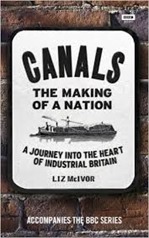 Canals: The making of a Nation by Liz McIvor is a tie-in with a BBC series of the same name, presented by the author. It is about canals in England from the mid-18th century through to the present day although most of the action takes place before the end of the 19th century.
Canals: The making of a Nation by Liz McIvor is a tie-in with a BBC series of the same name, presented by the author. It is about canals in England from the mid-18th century through to the present day although most of the action takes place before the end of the 19th century.
The chapters of the book match the episodes of the series which are thematic, rather than chronological. Each chapter introduces a different topic, loosely tied to a particular canal.
The book starts with a discussion of the growth of London, and the Grand Junction canal linking it to Birmingham. The guild system was a factor in limiting the growth of the capital until the mid-18th century. The “Bubble Act” of 1720, enacted in the aftermath of the South Sea Bubble likely also had an impact. It prevented the formation of any joint stock company without an act of parliament to approve. It was repealed in 1825 before the railways saw their enormous growth. The Grand Junction canal was built as Birmingham became a manufacturing hub and London a great city with many requirements for daily life, and also a showroom to at least the United Kingdom, if not the world.
I was chastened to discover that the Bridgewater canal, one of the earliest of “canal boom” projects of the 18th century is only just up the road from me in Chester. I’d always assumed it was close to the town of a very similar name in Somerset! Bridgewater is named for the Duke of Bridgewater, Francis Egerton, for which the pub just over the road from me is presumably named. The Bridgewater canal was built around 1760, linking the Duke’s coal mines at Worsley to Manchester. With this revelation I realise that the Bridgewater canal and the Liverpool to Manchester railway, the first exclusively steam railway, are sited very close to each other.
Support for manufacture was the theme of canal building in the North of England, and also around Birmingham with canals built to move bulky raw materials to factories placed to benefit from hydraulic power, and benevolent climates for the processing of materials such as cotton. Manufacturers such as Josiah Wedgewood were keen to see their fragile wares safely make the outward journey to the showrooms of London.
The Kennet and Avon canal was built to provide navigable water access from Bristol to London. William Smith, who produced the first geological map of Great Britain is introduced in this chapter. I read more about him in The Map that Changed the World by Simon Winchester. The digging of canal cuts and tunnels reveal the local geology. Nowadays we see canals as bucolic thoroughfares but when they were built they were raw cuts indicating industrialisation.
The Manchester Ship Canal was opened in 1894 to bypass the port of Liverpool, these were the dying days of canal building. 154 died in its construction and 1404 were seriously injured from a workforce of 16,361. For comparison, projects such as the 2012 London Olympics and the close-to-completion Crossrail project are of similar scale yet have casualty numbers hovering around zero although these are best-in-class projects for health and safety. In this chapter McIvor talks more of the Irish “navigators” who built the canals, and something of the early trade union movement.
The families that worked the canals were seen as outsiders, once the long networks were set up they led an itinerant lifestyle with no fixed church or school for their children. The Victorian moralists arguing for improved conditions for the boat families seem to do so from the point of view of pointing out how bloody awful they were!
It’s interesting to see the likes of Thomas Telford and John Rennie cropping up repeatedly in this book. They have the air of rockstar engineers, not a niche found these days. Perhaps this is a result of the work of the Victorian writer, Samuel Smiles, who was very keen on self-improvement and wrote biographies of these men to promote his ideas.
To me the book lacks a little prehistory, the great boom for canal building in the UK was at the end of the 18th century but the very first “pound lock” in England was built in 1566 on the Exeter canal. What went on between these two times? And what was happening elsewhere in the world? Perhaps the answer here is that the canals in Britain never represented a technological revolution, they were always about the social and commercial climate being right.
Canals: The Making of a Nation is an unchallenging read, well-suited to a holiday. If you’re on a canal boat it won’t tell you much about the particular bridges and tunnels you pass over but it will give you a strong feeling for the lives of the people that built and used the canals, and why they were built in the first place.
